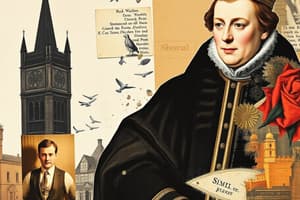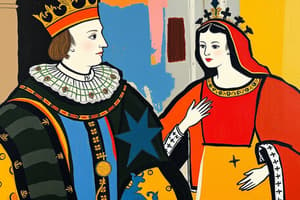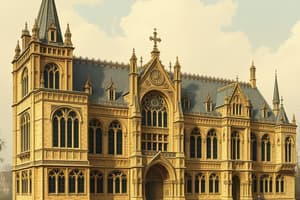Podcast
Questions and Answers
What was Somerset’s relationship to Lutheranism?
What was Somerset’s relationship to Lutheranism?
- He was strictly opposed to it.
- He fully embraced it.
- He had some sympathy towards it. (correct)
- He was indifferent to all reform movements.
Edward was able to direct religious policy effectively during his reign.
Edward was able to direct religious policy effectively during his reign.
False (B)
Who publicly denounced images in February 1547?
Who publicly denounced images in February 1547?
Nicholas Ridley
Somerset made his first forays into religious reform in ______.
Somerset made his first forays into religious reform in ______.
What risk did Somerset face if he fully embraced Lutheranism?
What risk did Somerset face if he fully embraced Lutheranism?
Somerset was eager to make rapid changes to England's religious direction.
Somerset was eager to make rapid changes to England's religious direction.
Which bishops did Somerset welcome into his household?
Which bishops did Somerset welcome into his household?
Match the following individuals with their roles:
Match the following individuals with their roles:
What did Eamon Duffy suggest about the general attitude of most people towards Catholic practices during reforms?
What did Eamon Duffy suggest about the general attitude of most people towards Catholic practices during reforms?
The Marian Restoration was embraced by congregations at a slow pace, indicating strong support for Protestant reforms.
The Marian Restoration was embraced by congregations at a slow pace, indicating strong support for Protestant reforms.
What was a common misconception among members of the laity regarding the reforms?
What was a common misconception among members of the laity regarding the reforms?
Most people's enthusiasm for Catholic practices persisted until they were _________.
Most people's enthusiasm for Catholic practices persisted until they were _________.
Match the following terms with their descriptions:
Match the following terms with their descriptions:
What was the significant change made to church services during Edward VI's reign?
What was the significant change made to church services during Edward VI's reign?
The Black Rubric proclamation clarified that kneeling during the Communion service was an act of worshipping an idol.
The Black Rubric proclamation clarified that kneeling during the Communion service was an act of worshipping an idol.
Who was removed from his see in February 1550, indicating a shift towards religious reform?
Who was removed from his see in February 1550, indicating a shift towards religious reform?
The ___ Book of Common Prayer was issued by Cranmer in January 1552.
The ___ Book of Common Prayer was issued by Cranmer in January 1552.
Match the following individuals with their contributions:
Match the following individuals with their contributions:
Which act made it illegal for clergy and laity to not attend church services?
Which act made it illegal for clergy and laity to not attend church services?
Bishop Hooper believed the pace of reform was aided by a cooperative public.
Bishop Hooper believed the pace of reform was aided by a cooperative public.
What was the primary focus of the reforms initiated during Edward VI's reign?
What was the primary focus of the reforms initiated during Edward VI's reign?
The 42 Articles expressed ideas of justification by ___ alone.
The 42 Articles expressed ideas of justification by ___ alone.
What percentage of the public in London seemed to enthusiastically embrace Protestantism?
What percentage of the public in London seemed to enthusiastically embrace Protestantism?
What significant act was passed by Parliament that helped remove the legal basis for Catholicism?
What significant act was passed by Parliament that helped remove the legal basis for Catholicism?
The Book of Common Prayer established the use of Latin in church services.
The Book of Common Prayer established the use of Latin in church services.
What was the primary challenge in assessing the religious reforms under Somerset?
What was the primary challenge in assessing the religious reforms under Somerset?
What was the main purpose of the Royal Injunctions issued?
What was the main purpose of the Royal Injunctions issued?
Somerset’s regency was characterized by a complete acceptance of Lutheranism and Calvinism.
Somerset’s regency was characterized by a complete acceptance of Lutheranism and Calvinism.
The practice of removing church decorations is known as __________.
The practice of removing church decorations is known as __________.
Match the following clergy actions with their requirements:
Match the following clergy actions with their requirements:
What was one of the major outcomes of Warwick's rise to power regarding religious shifts in England?
What was one of the major outcomes of Warwick's rise to power regarding religious shifts in England?
Which of the following was NOT a requirement given to priests?
Which of the following was NOT a requirement given to priests?
Bishop Hooper found that _____ of his 311 priests could not recite the Ten Commandments.
Bishop Hooper found that _____ of his 311 priests could not recite the Ten Commandments.
Somerset's proclamations in 1548 indicated that he was confident in the reforms he was implementing.
Somerset's proclamations in 1548 indicated that he was confident in the reforms he was implementing.
Which group was primarily at odds with John Hooper regarding the new Ordinal introduced in January 1550?
Which group was primarily at odds with John Hooper regarding the new Ordinal introduced in January 1550?
What was the outcome of the Chantries Act?
What was the outcome of the Chantries Act?
The Book of Common Prayer under Somerset denied the concept of purgatory.
The Book of Common Prayer under Somerset denied the concept of purgatory.
What was William Paget's assessment of the state of religion in England in mid-1549?
What was William Paget's assessment of the state of religion in England in mid-1549?
The __________ was a new prayer book that established the liturgy of the Church.
The __________ was a new prayer book that established the liturgy of the Church.
Which aspect of Catholicism was maintained even after the reforms?
Which aspect of Catholicism was maintained even after the reforms?
Warwick, later known as Northumberland, opted to align with the _____ in order to strengthen his position on the council.
Warwick, later known as Northumberland, opted to align with the _____ in order to strengthen his position on the council.
Match the following figures with their associated views on religious reform:
Match the following figures with their associated views on religious reform:
What best describes the religious reforms under Somerset according to the passage?
What best describes the religious reforms under Somerset according to the passage?
Flashcards are hidden until you start studying
Study Notes
Religious Development Under Somerset
- Edward VI, influenced by evangelical beliefs, lacked the authority to direct ecclesiastical policy due to his young age.
- Somerset, showing sympathy for Lutheranism, welcomed reformers but did not aim for radical changes.
- Edward's regency faced the dual challenge of balancing reform with the risk of alienating Catholic allies like Francis I and Charles V.
- Evangelicals, returning from exile, raised tensions, particularly when Bishop Nicholas Ridley condemned images in early 1547, leading to some abandoning the Mass.
- Somerset adopted a cautious approach, issuing Royal Injunctions in July 1547 that reinforced and expanded upon previous injunctions, leading to iconoclasm.
- Key measures included forbidding church decorations, mandating the English Bible, and enforcing English preaching by priests.
- Enforcement of reforms was initiated through visitations despite opposition from conservative bishops like Gardiner.
- In November 1547, Parliament repealed the Act of Six Articles, signalling a legal shift away from Catholicism and allowing for the growth of radical ideas.
- The Chantries Act of 1547 dissolved chantries, raising funds for military campaigns, while indicating a push toward evangelical thought.
- By 1548, unrest grew as radical texts circulated, leading Somerset to reassert Catholic rites and restrict preaching to control the pace of reform.
- The Book of Common Prayer, issued in 1549, represented a significant liturgical change, but retained elements of Catholicism like vestments and holy days.
- Somerset's reforms appeared insufficient, splitting the public between reformers and Catholics, leading to mixed adherence to the new practices.
Religious Reform Under Northumberland
- Removal of Somerset in October 1549 resulted in increased division within England’s religious landscape.
- Northumberland allied closely with evangelicals, eliminating conservative voices from the council.
- His leadership marked a shift towards a stronger evangelical path, influenced by radical reformist ideas prevalent between 1547 and 1550.
- Initial reforms faced controversy, as seen in John Hooper's clash with Cranmer over ordination procedures and vestment requirements.
- Legislative changes in 1550 mandated plain wooden altars and surplices for priests, continuing the trend of iconoclasm established under Somerset.
- 1551 saw further consolidation of evangelical control, with conservative bishops removed and church valuables confiscated.
- The second Book of Common Prayer, introduced in January 1552, eliminated Catholic vestiges, affirming the commemoration of the Eucharist without transubstantiation.
- The Second Book, backed by strict laws, aimed to enforce conformity through harsh penalties for noncompliance.
- The 42 Articles were presented in 1552, reflecting strong evangelical doctrines, though they were never enacted due to Edward's death in 1553.
Religious Reform Under Edward – Assessment
- By 1553, England was officially Protestant with an evangelical majority among bishops and a Protestant king.
- Reforms signified the influence of continental reformers but faced internal resistance from the laity.
- Evangelicals like Bucer critiqued the pace of reform, suggesting that public adherence was superficial and old superstitions remained prevalent.
- Bishop Hooper noted the public's reluctance to fully embrace the new doctrines, highlighting simmering opposition to imposed changes.### Protestants and Catholicism in Early Modern England
- Protestant enthusiasm in London was low, with only 20% showing real commitment to the movement.
- Catholicism maintained strong popularity in northern regions like Lancashire, Staffordshire, and Worcestershire.
- Eamon Duffy, in ‘The Stripping of the Altars,’ highlights that many individuals pragmatically adapted to survive under oppressive changes by selling their Catholic heritage.
- Most people retained affection for Catholic rituals until these practices were outright banned by authorities.
Understanding of Reforms
- Many laypeople and some clergy lacked a clear understanding of the implemented reforms, indicating confusion and resistance.
- Pragmatic behavior was prevalent until the reforms were enforced, suggesting individuals may not have genuinely supported Protestantism.
Indicators of Popular Sentiment
- Wills from various regions show differing levels of enthusiasm for religious reforms.
- The rapid acceptance of the Marian Restoration by congregations signifies a lack of true allegiance to Protestant reforms, revealing underlying Catholic sentiments.
Studying That Suits You
Use AI to generate personalized quizzes and flashcards to suit your learning preferences.




